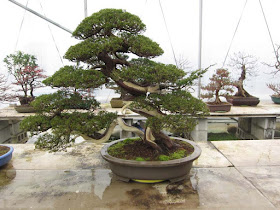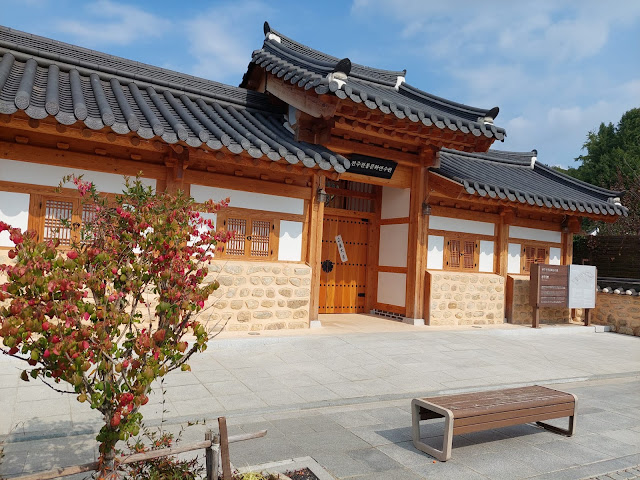Korea is famous for its lush gardens and beautiful landscapes. As a matter of fact, Bonsai's are popular in Korea. The yearly selling growth rate of Bonsai plants in South Korea is aproximately 5 % . One of the most famous Bonsai sights in Korea is Bunjae Museum, which offers thousands of different Bonsai trees on display. We visited in the middle of winter. Most of the lakes in the
surrounding parks had frozen and the top daytime temperatures were not even making it above freezing. When we first entered the nursery I wasn’t sure we were at the right place. I could hardly see any bonsai! We soon learnt that the whole collection was sheltering in huge greenhouses for the winter but that’s a whole other post. One of the most fascinating Bonsai trees is the Juniper, I happen to discover a beautiful Juniper at the Bunjae Museum. What was interesting about this nursery was how it was run. In the Japanese nurseries I have visited the trees that were living within the nursery either belonged to the nurseryman or a customer but nearly all the work was done on the trees by the professional nurseryman. This very interesting museum is basically the Korean version of Omiya museum of Japan.
Here in the Korean Bunjae Museum, hobby growers could rent bench space and grow their trees as they liked while enjoying the luxuries of a nursery such as misted green houses, regular watering, and a professional grower on site to call on for advice and or lessons etc. It seemed like a really good system and one I could see working well at other places. To imagine the ease at which you could take holidays without having to organise someone to water or without having to move the collection to a friends backyard makes this nurseries system seem like a great idea.
Now just because the growers in this green house were hobby growers it didn’t mean the trees were of a sub standard level. In fact there was a whole range of standards of trees many of which were very high leveled. The Bunjae Museum is for Bonsai enthusiasts an attraction by itself.
 |
Moving on to another beauty in Korea is the Spirited Garden at Jeju Island. I am sure that many of you have never heard the Spirited Garden before, well it can be found on any guide book of Jeju Island. Spirited Garden is the new name of Bunjae Arpia, renamed in 2007 to commemorate the 15th anniversary after opening and to renew the garden as an international garden. Hundreds of potted plants are located in Nature Garden with a theme of oreum and water.
The history of the garden started in 1963 when Seong Beomyeong, a director, came to Jeju and cultivated the wasteland full of rocks. The garden came into the international spotlight as the beautiful garden was created from the wastelands by a single farmer. The garden has been visited by many honored public figures such as Jiang Zemin and Hu Jintao from China, Nakasone from Japan, Kim Yongsun from North Korea and others. Currently, about 400 planted trees are on display. Also, visitors can see various facilities including stone walls and stone towers stacked with Jeju volcanic stones, the largest artificial waterfalls in Jeju, and a pond meeting the waterfalls with large-sized carp.
Grown out of long term observation and meditation over art and life, this Spirited Garden has been called one of the most beautiful garden in the world, attracting people from all over the world. It has become a ven - ue for some people to do exploration and research. Well, a visit to Jeju Island is an eye opening experience in general.
South Korea has a temperate climate with four distinct seasons which is ideal for the most varieties of Bonsai trees. Winters are usually long, cold and dry. Summers are very short, hot, and humid. Spring and autumn are pleasant but also short in duration. Seoul's mean temperature in January is -5 degrees Celsius to - 2.5° Celsius (23°- 27,5° Fahrenheit) and in July the mean temperature is about 22.5° C to 25° C (71°- 75° Fahrenheit).
The country generally has enough rainfall, rarely it does less than 75 centimeters of rain fall in any given year; for the most part, rainfall is over 100 centimeters. Amounts of precipitation can however vary from year to year. Serious droughts occur about once every eight years. About two-thirds of the annual precipitation occurs between June and September.
South Korea is less vulnerable to typhoons than neighboring countries. From one to three typhoons can be expected per year. Typhoons usually pass over South Korea in late summer, especially in August and bring torrential rains. All these ideal climate conditions are not only beneficial for Bonsai growers but also gardening activities. Lastly, I think its worth to visit South Korea, I have never regretted this unique experience to explore Korea from a different perspective. I would not necessarily go by tour groups which might not show you these hidden treasures.
Interesting Books on Bonsai can be found here:
The Complete Book of Bonsai --> I've been into bonsai for 25 years and this is the basic Bible for beginner and intermediate bonsai enthusiasts. It has an excellent section on techniques, including pruning, wiring and whatnot, and it has a large species-specific tree guide. If you're into bonsai and want only one book, this is it.
Indoor Bonsai The Great Selection --> Creating beautiful, healthy bonsai is a wonderful skill that anyone can learn, with a little time, patience, and this all-inclusive manual. With color photos and drawings to illustrate the points, it introduces all the cultivation techniques; offers expert advice on location, soil types, watering, and pest control; and provides intricate instruction on training the bonsai--including pruning, wiring and stretching it.
The Secret Techniques of Bonsai --> In The Secret Techniques of Bonsai, the author of the groundbreaking Bonsai With American Trees teams up with his son to offer not only the basics for creating perfect bonsai, but also secret techniques they’ve developed over years of careful work and observation.
Bonsai Survival Manual --> Problem solving when your Bonsai get sick. Expand your gardening repertoire as you create a captivating and exquisite miniature world. In this introductory guide, Colin Lewis covers everything you need to know to design, grow, and successfully maintain attractive bonsai.
Bonsai and the art of Penjing --> Bonsai & Penjing, Ambassadors of Beauty and Peace describes how Chinese penjing and North American bonsai were later added to the Museum, making its collection the most comprehensive in the world. Stories of individual trees and forest plantings are featured, as are the roles played by the skilled and talented creators of these living art forms people such as John Naka, Saburo Kato, Yuji Yoshimura, Harry Hirao, and Dr. Yee-Sun Wu.
Bonsai and the art of Penjing --> Bonsai & Penjing, Ambassadors of Beauty and Peace describes how Chinese penjing and North American bonsai were later added to the Museum, making its collection the most comprehensive in the world. Stories of individual trees and forest plantings are featured, as are the roles played by the skilled and talented creators of these living art forms people such as John Naka, Saburo Kato, Yuji Yoshimura, Harry Hirao, and Dr. Yee-Sun Wu.
Bonsai with Japanese Maples --> With their delicate foliage, seasonal color changes, and intricate pattern of branching, Japanese maples are among the most popular and suitable plants for bonsai design. In this long-awaited book, internationally renowned expert Peter Adams discusses both the specific horticultural needs of Japanese maples as bonsai subjects and illustrates proven techniques for creating and maintaining beautiful specimens.
The Modern Bonsai Practice --> The most current, useful information on growing Bonsai. Fresh, practical, definitive, comprehensive reference guide to the finest art of horticulture: growing miniature trees. Common sense bonsai answers separating myth from fact with depth and detail. Appropriate for both bonsai hobbyists and experienced practitioners.
More Bonsai articles can be found here:
Please click here for more information on --> Chinese Penjing Bonsai
Please click here for more information on --> The Origins of Bonsai
Please click here for more information on --> The Art of Saikei Bonsai
Please click here for more information on --> Japanese Tanuki Bonsai
Please click here for more information on --> How to Water a Bonsai
Please click here for more information on --> Bonsai Healing Methods
Thank you for visiting my blog and feel free to subscribe or leave your message at the comment section below. Please always remember, good feedback's or bad remarks, it doesn't matter!













No comments:
Post a Comment